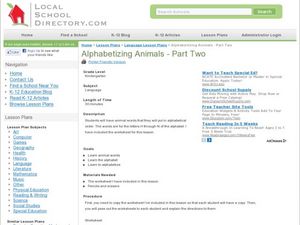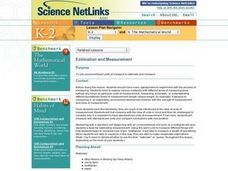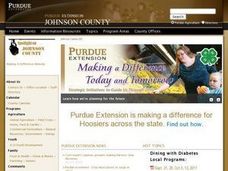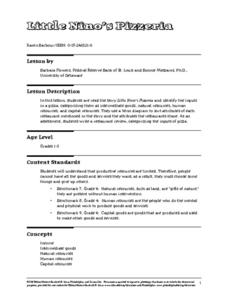Curated OER
Characterization
Students read the book Sylvester and the Magic Pebble. For this character traits lesson, students read the book and identify character traits. Students draw pictures of a character from the book and describe the character traits.
Curated OER
Tamar Burris
Students explore genetics. In this life cycle activity, students consider the meaning of "genes" and "heredity" as they watch a video about the topics. Students then research their own genetic make-up as they interview family members....
Curated OER
Brown Paper Bag Simple Machine
Students explore simple machines. In this simple machines science lesson, students work with a partner to identify what kind of simple machine is represented by a variety of household objects placed in paper bags. Students...
Curated OER
Habitats of the World
Students discover that the Earth supports many different animal habitats. In this habitat lesson students research different habitats of the world. Students show how the animals in their habitat are adapted.
Curated OER
Alphabetizing Animals- Part Two
Students identify animal names and put them into alphabetical order. In this word study lesson plan, students recite the names of animals and alphabetize the names. Students complete a worksheet as a follow-up activity.
Curated OER
Who is George Washington Carver, Anyway?
Learners read about George Washington Carver, then work in small groups to design, write and illustrate a booklet about his accomplishments.
Curated OER
Rosa Parks Refused to Do What?
First graders listen to two books about Rosa Parks. They contribute factual information for a web. They listen to an interview with Rosa Parks on the internet, adding more information to the web. They write and illustrate a book using...
Curated OER
Plant Parts We Eat
I bet the kids in your class will love to eat their vegetables after an engaging lesson about edible plants. They read information about vegetables and edible plants, sort vocabulary words, identify plant parts, measure and graph the...
Curated OER
Contaminated Drinking Water
Students predict, experiment, and draw conclusions about the safety of drinking water. In this ecology lesson, students participate in an experiment to determine if they can taste or see contamination in drinking water. Data is collected...
Curated OER
Estimation and Measurement
Learners explore measurement and estimation with non-standard units. For this measurement lesson, students discuss items that could be used to measure; they use tooth picks to measure specific items around the classroom, both estimating...
Curated OER
Make Mine Turkey
Young scholars compare foods available for the Pilgrims' Thanksgiving with contemporary Thanksgiving foods. After reading information about the first Thanksgiving, pupils create a menu and compute the cost of a turkey dinner, using...
Federal Reserve Bank
Little Nino's Pizzeria
Engage your youngsters in basic economics by connecting the terms to dessert and pizza! After a discussion about intermediate goods and natural resources, learners read and connect a pizzeria to economic terms.
National Wildlife Federation
Massive Migrations
Turn your students into flocks of migratory birds for this fun lesson on animal migration. Prior to the activity, the teacher creates four different migration routes in the classroom or any available open space, labeling nesting...
Curated OER
Make Bark and Leaf Rubbings
Students explore natural resources by creating art from plant materials. In this leaf rubbings lesson, students identify the plants that shed bark and leaves and discuss how it helps them survive in specific environments. Students...
Curated OER
Three-Meal Weather: Food inspired adjectives from "Cloudy with a Chance of Meatballs"
Students complete a list of food adjectives based on the book Cloudy With A Chance of Meatballs. For this adjectives lesson plan, students also compose a 3 part piece of writing based on an entire day of raining food.
Curated OER
Edward Jenner
Here is an interesting lesson that tells the story of Edward Jenner, who came up with an immunization for smallpox. After watching a video that describes him, learners use an outline of a man to draw his picture and write down some facts...
Curated OER
Acrostic Book Report
Learners read the story Wild Horse Winter and construct acrostic poems. In this poetry lesson, students use adjectives and events in the text to develop an acrostic poem.
Curated OER
What Size Is It?
The concept of size is taught in this comparitive meaning of words lesson. Learners discuss the comparative qualities of words such as small, smaller, smallest. They demonstrate their understanding by drawing a picture.
Curated OER
Calligraphy, Handwriting And The Alphabet
Students produce calligraphy projects using writing skills and unique tools in this six-day Art activity. Emphasis is placed upon the work of Portland, Oregon calligraphy artist Inga Dubay and her experiences with "Italic" writing...
Curated OER
A Picture's Worth 1000 Words: Decoding Intercultural Symbols
Students interpret a set of pictographs, defining what each image means and create their own set of symbols as an alphabet. They then write using their own symbolic alphabet using pictures.
Curated OER
Time Line of the Year
Students record special events and memories on a timeline of the school year. For this timeline lesson, students understand the purpose of a timeline as they chart important events of the school year using photos, drawings, handprints,...
Curated OER
Re-Name That Tune
Young scholars select a familiar children's tune and redesign it by rewriting the lyrics, writing a play, a dance, a storybook or a puppet show. Students work in groups and share their finished project with their classmates.
Curated OER
Inferring Character Traits
Here is a lesson which is "flexible," and can operate as an individual or whole class activity. After reading a book of their choosing, with the use of a semantic map, learners identify character traits. They infer how their feelings...
Curated OER
Welcome to My Community!
A "Welcome to Our Community" brochure culminates research into the people and places of interest in your community. Class members work alone or in pairs to gather information, illustrate, and write about various topics. Materials are...























